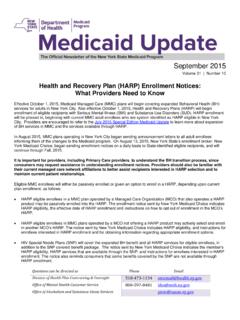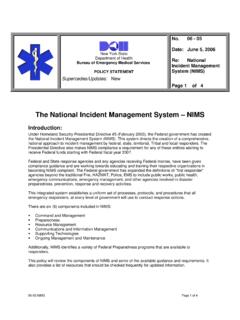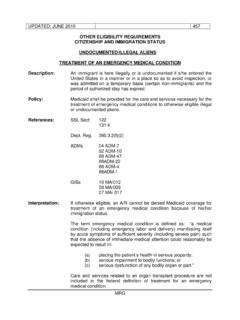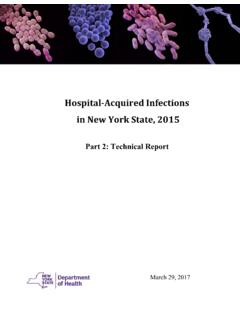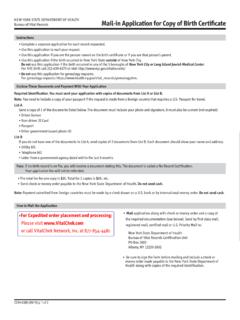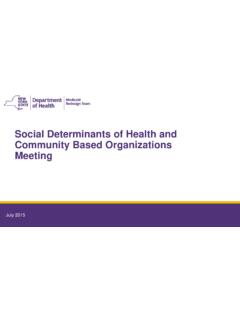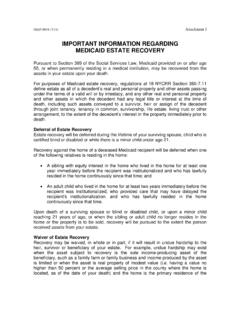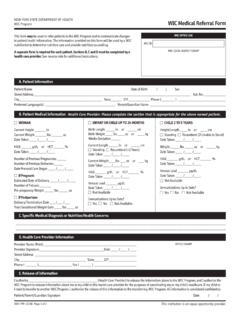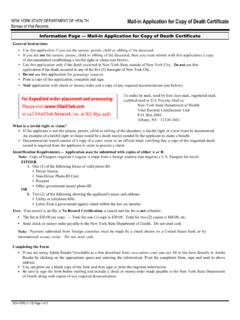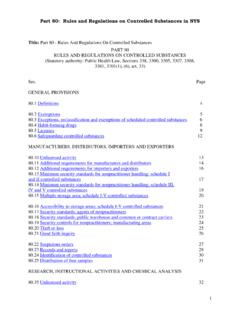Transcription of VENTILATOR ALLOCATION GUIDELINES
1 VENTILATOR ALLOCATION GUIDELINES New York State Task Force on Life and the Law New York State Department of Health November 2015 Current Members of the New York State Task Force on Life and the Law Howard A. Zucker, , Commissioner of Health, New York State Karl P. Adler, Cardinal s Delegate for Health Care, Archdiocese of NY Donald P. Berens, Jr., Former General Counsel, New York State Department of Health Rabbi J. David Bleich, Professor of Talmud, Yeshiva University, Professor of Jewish Law and Ethics, Benjamin Cardozo School of Law Rock Brynner, , Professor and Author Karen A. Butler, , Partner, Thuillez, Ford, Gold, Butler & Young, LLP Yvette Calderon, , Professor of Clinical Emergency Medicine, Albert Einstein College of Medicine Carolyn Corcoran, Principal, James P.
2 Corcoran, LLC Nancy Neveloff Dubler, Consultant for Ethics, NYC Health & Hospitals Corp., Professor Emerita, Albert Einstein College of Medicine Paul J. Edelson, Professor of Clinical Pediatrics, College of Physicians and Surgeons, Columbia University Joseph J. Fins, , Chief, Division of Medical Ethics, Weill Medical College of Cornell University Rev. Francis H. Geer, Rector, St. Philip s Church in the Highlands Samuel Gorovitz, Professor of Philosophy, Syracuse University Cassandra E. Henderson, , , Director of Maternal Fetal Medicine, Lincoln Medical and Mental Health Center Hassan Khouli, , Chief, Critical Care Section, St. Luke s Roosevelt Hospital Fr. Joseph W. Koterski, Professor, Fordham University Rev. H. Hugh Maynard-Reid, , , Director, Pastoral Care, North Brooklyn Health Network, New York City Health and Hospitals Corporation John D.
3 Murnane, Partner, Fitzpatrick, Cella, Harper & Scinto Karen Porter, , Professor, Brooklyn Law School Robert Swidler, VP, Legal Services, St. Peter's Health Partners Sally T. True, Partner, True, Walsh & Sokoni, LLP Task Force on Life and the Law Staff Stuart C. Sherman, , Executive Director Susie A. Han, , Deputy Director, Principal Policy Analyst Project Chair of the VENTILATOR ALLOCATION GUIDELINES Valerie Gutmann Koch, Special Advisor; Former Senior Attorney Task Force reports should not be regarded as reflecting the views of the organizations with which Task Force members are associated. Letter from the Commissioner of Health Dear New Yorkers, Protecting the health and well-being of New Yorkers is a core objective of the Department of Health. During flu season, we are reminded that pandemic influenza is a foreseeable threat, one that we cannot ignore.
4 In light of this possibility, the Department is taking steps to prepare for a pandemic and to limit the loss of life and other negative consequences. An influenza pandemic would affect all New Yorkers, and we have a responsibility to plan now. Part of the planning process is to develop guidance on how to ethically allocate limited resources ( , ventilators) during a severe influenza pandemic while saving the most lives. As part of our emergency preparedness efforts, the Department, together with the New York State Task Force on Life and the Law, is releasing the 2015 VENTILATOR ALLOCATION GUIDELINES , which provide an ethical, clinical, and legal framework to assist health care providers and the general public in the event of a severe influenza pandemic. The first GUIDELINES in 2007 focused on the ALLOCATION of ventilators for adults, and were among the first of their kind in the United States.
5 The 2015 version is also groundbreaking in that it includes two new detailed clinical VENTILATOR ALLOCATION protocols one for pediatric patients and another for neonates. The first GUIDELINES were widely cited and followed by other states. We expect these revised GUIDELINES to have a similar effect. The GUIDELINES were written to reflect the values of New Yorkers, and extensive efforts were made to obtain public input during their development. While these GUIDELINES are comprehensive, they are by no means final. We will continue to seek public input and will revise the GUIDELINES as societal norms change and clinical knowledge advances. It is my sincere hope that these GUIDELINES will never need to be implemented. But as a physician and servant in public health, I know that such preparations are essential should we ever experience an influenza pandemic.
6 I want to thank the members and staff of the Task Force on Life and the Law for their efforts in creating these GUIDELINES , which once again demonstrate New York s strong commitment to safeguarding the health of its citizens. Sincerely, Howard A. Zucker, , , New York State Commissioner of Health VENTILATOR ALLOCATION GUIDELINES New York State Task Force on Life & the Law New York State Department of Health Preface These VENTILATOR ALLOCATION GUIDELINES ( GUIDELINES ) are an update to the 2007 draft GUIDELINES , which presented a clinical VENTILATOR ALLOCATION protocol for adults and included a brief section on the legal issues associated with implementing the GUIDELINES . This update of the GUIDELINES consists of four chapters: (1) the adult GUIDELINES , (2) the pediatric GUIDELINES , (3) the neonatal GUIDELINES , and (4) legal considerations.
7 The adult GUIDELINES were revised to reflect recent medical advances and further clinical analysis. The pediatric and neonatal GUIDELINES are new and address important and previously overlooked segments of the population. Finally, the legal section provides a comprehensive examination of the various legal issues that may arise when implementing the GUIDELINES . The underlying goal of this work is to provide a thorough ethical, clinical, and legal analysis of the development and implementation of the GUIDELINES in New York State. In addition to detailed clinical VENTILATOR ALLOCATION protocols, this document provides an account of the logic, reasoning, and analysis behind the GUIDELINES . The clinical VENTILATOR ALLOCATION protocols are grounded in a solid ethical and legal foundation and balance the goal of saving the most lives with important societal values, such as protecting vulnerable populations, to build support from both the general public and health care staff.
8 These VENTILATOR ALLOCATION GUIDELINES provide an ethical, clinical, and legal framework that will assist health care workers and facilities and the general public in the ethical ALLOCATION of ventilators during an influenza pandemic. Because the GUIDELINES are a living document, intended to be updated and revised in line with advances in clinical knowledge and societal norms, the ongoing feedback from clinicians and the public has and will continue to be sought. In developing a protocol for allocating scarce resources in the event of an influenza pandemic, the importance of genuine public outreach, education, and engagement cannot be overstated; they are critical to the development of just policies and the establishment of public trust. Acknowledgements The participation of clinicians, researchers, and legal experts was critical to the deliberations of the Task Force.
9 In addition to the members of the adult, pediatric, and clinical workgroups (see Appendix B of each respective chapter) and legal subcommittee, we would like to thank Armand H. Matheny Antommaria, Kenneth A. Berkowitz, Penelope R. Buschman, Sandro Cinti, Laura Evans, W. Bradley Poss, William Schechter, and Mary Ellen Tresgallo for their invaluable insights. We would like to thank former Task Force policy interns Apoorva Ambavane, Sara Bergstresser, Jason Keehn, Jordan Lite, Daniel Marcus-Toll, Felisha Miles, Nicole Naud , Katy Skimming, and Maryanne Tomazic for their research and editing contributions. In addition, we would like to extend special thanks to former legal interns Carol Brass, Bryant Cobb, Andrew Cohen, Marissa Geoffory, Victoria Kusel, Brendan Parent, Lillian Ringel, Phoebe Stone, David Trompeter, and Esther Warshauer-Baker.
10 Finally, we would like to acknowledge the work of former Task Force staff members who contributed to the GUIDELINES . We thank former Executive Directors Tia Powell and Beth Roxland, who initiated and moved the report forward, respectively. Carrie Zoubul served as the Senior Attorney during a large portion of the research and writing of these GUIDELINES and oversaw the 2011 public engagement project. The Task Force s previous reports have been instrumental in developing policy on issues arising at the intersection of law, medicine, and ethics and have impacted greatly the delivery of health care in New York. While the Task Force hopes that the GUIDELINES will never need to be implemented, we believe the GUIDELINES will help to ensure that the State is adequately and appropriately prepared in the event of an influenza pandemic.
